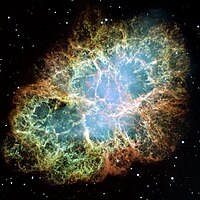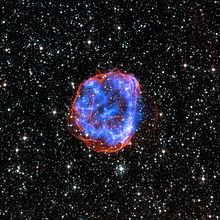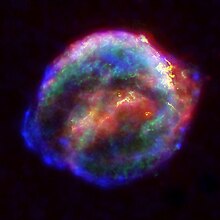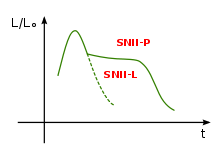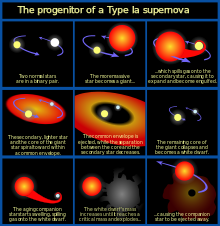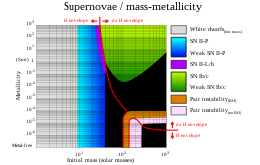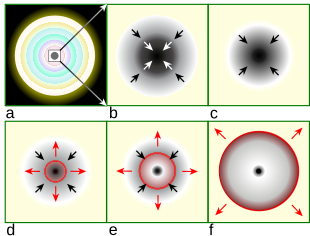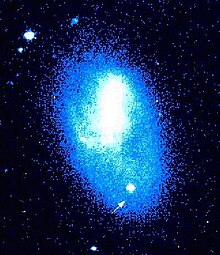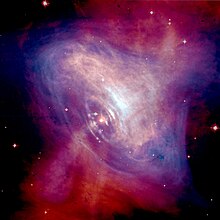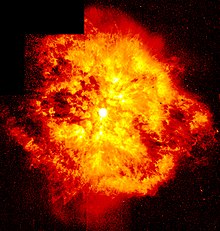SN 1994D (bright spot on the lower left), a Type Ia supernova within its host galaxy, NGC 4526
A supernova (/ˌsuːpərnoʊvə/ plural: supernovae /ˌsuːpərnoʊviː/ or supernovas, abbreviations: SN and SNe) is an event that occurs upon the death of certain types of stars.
Supernovae are more energetic than novae. In Latin, nova
means "new", referring astronomically to what appears to be a temporary
new bright star. Adding the prefix "super-" distinguishes supernovae
from ordinary novae, which are far less luminous. The word supernova was coined by Walter Baade and Fritz Zwicky in 1931.
Only three Milky Way, naked-eye supernova events have been observed during the last thousand years, though many have been seen in other galaxies. The most recent directly observed supernova in the Milky Way was Kepler's Supernova in 1604, but two more recent supernova remnants
have also been found. Statistical observations of supernovae in other
galaxies suggest they occur on average about three times every century
in the Milky Way, and that any galactic supernova would almost certainly
be observable with modern astronomical telescopes.
Supernovae may expel much, if not all, of the material away from a star at velocities up to 30,000 km/s or 10% of the speed of light. This drives an expanding and fast-moving shock wave into the surrounding interstellar medium, and in turn, sweeping up an expanding shell of gas and dust, which is observed as a supernova remnant. Supernovae create, fuse and eject the bulk of the chemical elements produced by nucleosynthesis. Supernovae play a significant role in enriching the interstellar medium with the heavier atomic mass chemical elements. Furthermore, the expanding shock waves from supernovae can trigger the formation of new stars. Supernova remnants are expected to accelerate a large fraction of galactic primary cosmic rays, but direct evidence for cosmic ray production was found only in a few of them so far. They are also potentially strong galactic sources of gravitational waves.
Theoretical studies indicate that most supernovae are triggered by one of two basic mechanisms: the sudden re-ignition of nuclear fusion in a degenerate star or the sudden gravitational collapse of a massive star's core. In the first instance, a degenerate white dwarf may accumulate sufficient material from a binary companion, either through accretion or via a merger, to raise its core temperature enough to trigger runaway nuclear fusion, completely disrupting the star. In the second case, the core of a massive star may undergo sudden gravitational collapse, releasing gravitational potential energy
as a supernova. While some observed supernovae are more complex than
these two simplified theories, the astrophysical collapse mechanics have
been established and accepted by most astronomers for some time.
Due to the wide range of astrophysical consequences of these
events, astronomers now deem supernova research, across the fields of
stellar and galactic evolution, as an especially important area for
investigation.
Observation history
The earliest recorded supernova HB9 was viewed by Indians roughly 5,000-years ago and recorded in the oldest Star chart. Later, the SN 185, was viewed by Chinese astronomers in 185 AD. The brightest recorded supernova was SN 1006, which occurred in 1006 AD and was described by observers across China, Japan, Iraq, Egypt, and Europe. The widely observed supernova SN 1054 produced the Crab Nebula. Supernovae SN 1572 and SN 1604,
the latest to be observed with the naked eye in the Milky Way galaxy,
had notable effects on the development of astronomy in Europe because
they were used to argue against the Aristotelian idea that the universe beyond the Moon and planets was static and unchanging. Johannes Kepler
began observing SN 1604 at its peak on October 17, 1604, and continued
to make estimates of its brightness until it faded from naked eye view a
year later. It was the second supernova to be observed in a generation (after SN 1572 seen by Tycho Brahe in Cassiopeia).
There is some evidence that the youngest galactic supernova, G1.9+0.3, occurred in the late 19th century, considerably more recently than Cassiopeia A from around 1680.
Neither supernova was noted at the time. In the case of G1.9+0.3, high
extinction along the plane of the galaxy could have dimmed the event
sufficiently to go unnoticed. The situation for Cassiopeia A is less
clear. Infrared light echos have been detected showing that it was a type IIb supernova and was not in a region of especially high extinction.
Before the development of the telescope, only five supernovae were seen in the last millennium.
Compared to a star's entire history, the visual appearance of a
galactic supernova is very brief, perhaps spanning several months, so
that the chances of observing one is roughly once in a lifetime. Only a
tiny fraction of the 100 billion stars in a typical galaxy have the capacity to become a supernova, restricted to either those having large mass or extraordinarily rare kinds of binary stars containing white dwarfs.
However, observation and discovery of extragalactic supernovae are now far more common. The first such observation was of SN 1885A in the Andromeda galaxy.
Today, amateur and professional astronomers are finding several hundred
every year, some when near maximum brightness, others on old
astronomical photographs or plates. American astronomers Rudolph Minkowski and Fritz Zwicky developed the modern supernova classification scheme beginning in 1941. During the 1960s, astronomers found that the maximum intensities of supernovae could be used as standard candles, hence indicators of astronomical distances.
Some of the most distant supernovae observed in 2003, appeared dimmer
than expected. This supports the view that the expansion of the universe is accelerating. Techniques were developed for reconstructing supernovae events that have no written records of being observed. The date of the Cassiopeia A supernova event was determined from light echoes off nebulae, while the age of supernova remnant RX J0852.0-4622 was estimated from temperature measurements and the gamma ray emissions from the radioactive decay of titanium-44.
SN Antikythera, SN Eleanor and SN Alexander at galaxy cluster RXC J0949.8+1707.
The most luminous supernova ever recorded is ASASSN-15lh. It was first detected in June 2015 and peaked at 570 billion L☉, which is twice the bolometric luminosity of any other known supernova.
However, the nature of this supernova continues to be debated and
several alternative explanations have been suggested, e.g. tidal
disruption of a star by a black hole.
Among the earliest detected since time of detonation, and for
which the earliest spectra have been obtained (beginning at 6 hours
after the actual explosion), is the Type II SN 2013fs (iPTF13dqy) which was recorded 3 hours after the supernova event on 6 October 2013 by the Intermediate Palomar Transient Factory (iPTF). The star is located in a spiral galaxy named NGC 7610, 160 million light years away in the constellation of Pegasus.
On 20 September 2016, amateur astronomer Victor Buso from Rosario, Argentina was testing out his new 16 inch telescope. When taking several twenty second exposures of galaxy NGC 613,
Buso chanced upon a supernova that had just become visible on earth.
After examining the images he contacted the Instituto de Astrofísica de
La Plata. "It was the first time anyone had ever captured the initial
moments of the “shock breakout” from an optical supernova, one not
associated with a gamma-ray or X-ray burst."
The odds of capturing such an event were put between one in ten million
to one in a hundred million, according to astronomer Melina Bersten
from the Instituto de Astrofísica.
The supernova Buso observed was a Type IIb made by a star twenty times
the mass of the sun. Astronomer Alex Filippenko, from the University of California,
remarked that professional astronomers had been searching for such an
event for a long time. He stated: "Observations of stars in the first
moments they begin exploding provide information that cannot be directly
obtained in any other way."
Discovery
Early work on what was originally believed to be simply a new category of novae was performed during the 1930s by two astronomers named Walter Baade and Fritz Zwicky at Mount Wilson Observatory. The name super-novae was first used during 1931 lectures held at Caltech by Baade and Zwicky, then used publicly in 1933 at a meeting of the American Physical Society. By 1938, the hyphen had been lost and the modern name was in use. Because supernovae are relatively rare events within a galaxy, occurring about three times a century in the Milky Way, obtaining a good sample of supernovae to study requires regular monitoring of many galaxies.
Supernovae in other galaxies cannot be predicted with any
meaningful accuracy. Normally, when they are discovered, they are
already in progress. Most scientific interest in supernovae—as standard candles
for measuring distance, for example—require an observation of their
peak luminosity. It is therefore important to discover them well before
they reach their maximum. Amateur astronomers,
who greatly outnumber professional astronomers, have played an
important role in finding supernovae, typically by looking at some of
the closer galaxies through an optical telescope and comparing them to earlier photographs.
Toward the end of the 20th century astronomers increasingly turned to computer-controlled telescopes and CCDs for hunting supernovae. While such systems are popular with amateurs, there are also professional installations such as the Katzman Automatic Imaging Telescope. The Supernova Early Warning System (SNEWS) project uses a network of neutrino detectors to give early warning of a supernova in the Milky Way galaxy. Neutrinos are particles that are produced in great quantities by a supernova, and they are not significantly absorbed by the interstellar gas and dust of the galactic disk.
"A star set to explode", the SBW1 nebula surrounds a massive blue supergiant in the Carina Nebula.
Supernova searches fall into two classes: those focused on relatively
nearby events and those looking farther away. Because of the expansion of the universe, the distance to a remote object with a known emission spectrum can be estimated by measuring its Doppler shift (or redshift);
on average, more-distant objects recede with greater velocity than
those nearby, and so have a higher redshift. Thus the search is split
between high redshift and low redshift, with the boundary falling around
a redshift range of z=0.1–0.3—where z is a dimensionless measure of the spectrum's frequency shift.
High redshift searches for supernovae usually involve the
observation of supernova light curves. These are useful for standard or
calibrated candles to generate Hubble diagrams
and make cosmological predictions. Supernova spectroscopy, used to
study the physics and environments of supernovae, is more practical at
low than at high redshift.
Low redshift observations also anchor the low-distance end of the
Hubble curve, which is a plot of distance versus redshift for visible
galaxies.
Naming convention
Supernova discoveries are reported to the International Astronomical Union's Central Bureau for Astronomical Telegrams, which sends out a circular with the name it assigns to that supernova. The name is the marker SN
followed by the year of discovery, suffixed with a one or two-letter
designation. The first 26 supernovae of the year are designated with a
capital letter from A to Z. Afterward pairs of lower-case letters are used: aa, ab, and so on. Hence, for example, SN 2003C designates the third supernova reported in the year 2003. The last supernova of 2005 was SN 2005nc, indicating that it was the 367th
supernova found in 2005. Since 2000, professional and amateur
astronomers have been finding several hundreds of supernovae each year
(572 in 2007, 261 in 2008, 390 in 2009; 231 in 2013).
Historical supernovae are known simply by the year they occurred: SN 185, SN 1006, SN 1054, SN 1572 (called Tycho's Nova) and SN 1604 (Kepler's Star). Since 1885 the additional letter notation has been used, even if there was only one supernova discovered that year (e.g. SN 1885A, SN 1907A, etc.) — this last happened with SN 1947A. SN,
for SuperNova, is a standard prefix. Until 1987, two-letter
designations were rarely needed; since 1988, however, they have been
needed every year.
Classification
Artist's impression of supernova 1993J.
As part of the attempt to understand supernovae, astronomers have classified them according to their light curves and the absorption lines of different chemical elements that appear in their spectra. The first element for division is the presence or absence of a line caused by hydrogen. If a supernova's spectrum contains lines of hydrogen (known as the Balmer series in the visual portion of the spectrum) it is classified Type II; otherwise it is Type I. In each of these two types there are subdivisions according to the presence of lines from other elements or the shape of the light curve (a graph of the supernova's apparent magnitude as a function of time).
| Type I No hydrogen |
Type Ia Presents a singly ionized silicon (Si II) line at 615.0 nm (nanometers), near peak light |
Thermal runaway | ||||||
| Type Ib/c Weak or no silicon absorption feature |
Type Ib Shows a non-ionized helium (He I) line at 587.6 nm |
Core collapse | ||||||
| Type Ic Weak or no helium | ||||||||
| Type II Shows hydrogen |
Type II-P/L/N Type II spectrum throughout |
Type II-P/L No narrow lines |
Type II-P Reaches a "plateau" in its light curve | |||||
| Type II-L Displays a "linear" decrease in its light curve (linear in magnitude versus time). | ||||||||
| Type IIn Some narrow lines | ||||||||
| Type IIb Spectrum changes to become like Type Ib | ||||||||
Type I
Type I supernovae are subdivided on the basis of their spectra, with Type Ia showing a strong ionised silicon absorption line.
Type I supernovae without this strong line are classified as Type Ib
and Ic, with Type Ib showing strong neutral helium lines and Type Ic
lacking them. The light curves are all similar, although Type Ia are
generally brighter at peak luminosity, but the light curve is not
important for classification of Type I supernovae.
A small number of Type Ia supernovae exhibit unusual features
such as non-standard luminosity or broadened light curves, and these are
typically classified by referring to the earliest example showing
similar features. For example, the sub-luminous SN 2008ha is often referred to as SN 2002cx-like or class Ia-2002cx.
A small proportion of type Ic supernovae show highly broadened
and blended emission lines which are taken to indicate very high
expansion velocities for the ejecta. These have been classified as type
Ic-BL or Ic-bl.[54]
Type II
Light curves are used to classify Type II-P and Type II-L supernovae
The supernovae of Type II can also be sub-divided based on their spectra. While most Type II supernovae show very broad emission lines which indicate expansion velocities of many thousands of kilometres per second, some, such as SN 2005gl, have relatively narrow features in their spectra. These are called Type IIn, where the 'n' stands for 'narrow'.
A few supernovae, such as SN 1987K and SN 1993J,
appear to change types: they show lines of hydrogen at early times,
but, over a period of weeks to months, become dominated by lines of
helium. The term "Type IIb" is used to describe the combination of features normally associated with Types II and Ib.
Type II supernovae with normal spectra dominated by broad
hydrogen lines that remain for the life of the decline are classified on
the basis of their light curves. The most common type shows a
distinctive "plateau" in the light curve shortly after peak brightness
where the visual luminosity stays relatively constant for several months
before the decline resumes. These are called Type II-P referring to the
plateau. Less common are Type II-L supernovae that lack a distinct
plateau. The "L" signifies "linear" although the light curve is not
actually a straight line.
Supernovae that do not fit into the normal classifications are designated peculiar, or 'pec'.
Types III, IV, and V
Fritz Zwicky
defined additional supernovae types, although based on a very few
examples that did not cleanly fit the parameters for a Type I or Type II
supernova. SN 1961i in NGC 4303
was the prototype and only member of the Type III supernova class,
noted for its broad light curve maximum and broad hydrogen Balmer lines
that were slow to develop in the spectrum. SN 1961f in NGC 3003 was the prototype and only member of the Type IV class, with a light curve similar to a Type II-P supernova, with hydrogen absorption lines but weak hydrogen emission lines. The Type V class was coined for SN 1961V in NGC 1058, an unusual faint supernova or supernova impostor
with a slow rise to brightness, a maximum lasting many months, and an
unusual emission spectrum. The similarity of SN 1961V to the Eta Carinae Great Outburst was noted. Supernovae in M101 (1909) and M83 (1923 and 1957) were also suggested as possible Type IV or Type V supernovae.
These types would now all be treated as peculiar Type II
supernovae, of which many more examples have been discovered, although
it is still debated whether SN 1961V was a true supernova following an LBV outburst or an impostor.
Current models
Sequence shows the rapid brightening and slower fading of a supernova in the galaxy NGC 1365 (the bright dot close to the upper part of the galactic center)
The type codes, described above given to supernovae, are taxonomic
in nature: the type number describes the light observed from the
supernova, not necessarily its cause. For example, Type Ia supernovae
are produced by runaway fusion ignited on degenerate white dwarf
progenitors while the spectrally similar Type Ib/c are produced from
massive Wolf–Rayet progenitors by core collapse. The following
summarizes what is currently believed to be the most plausible
explanations for supernovae.
Thermal runaway
Formation of a Type Ia supernova
A white dwarf star may accumulate sufficient material from a stellar companion to raise its core temperature enough to ignite carbon fusion, at which point it undergoes runaway nuclear fusion, completely disrupting it. There are three avenues by which this detonation is theorized to happen: stable accretion
of material from a companion, the collision of two white dwarfs, or
accretion that causes ignition in a shell that then ignites. The
dominant mechanism by which Type Ia supernovae are produced remains
unclear.
Despite this uncertainty in how Type Ia supernovae are produced, Type
Ia supernovae have very uniform properties, and are useful standard
candles over intergalactic distances. Some calibrations are required to
compensate for the gradual change in properties or different frequencies
of abnormal luminosity supernovae at high red shift, and for small
variations in brightness identified by light curve shape or spectrum.
Normal Type Ia
There are several means by which a supernova of this type can form, but they share a common underlying mechanism. If a carbon-oxygen white dwarf accreted enough matter to reach the Chandrasekhar limit of about 1.44 solar masses (M☉) (for a non-rotating star), it would no longer be able to support the bulk of its mass through electron degeneracy pressure
and would begin to collapse. However, the current view is that this
limit is not normally attained; increasing temperature and density
inside the core ignite carbon fusion as the star approaches the limit (to within about 1%), before collapse is initiated.
Within a few seconds, a substantial fraction of the matter in the
white dwarf undergoes nuclear fusion, releasing enough energy (1–2×1044 J) to unbind the star in a supernova. An outwardly expanding shock wave is generated, with matter reaching velocities on the order of 5,000–20,000 km/s, or roughly 3% of the speed of light. There is also a significant increase in luminosity, reaching an absolute magnitude of −19.3 (or 5 billion times brighter than the Sun), with little variation.
The model for the formation of this category of supernova is a closed binary star system. The larger of the two stars is the first to evolve off the main sequence, and it expands to form a red giant.
The two stars now share a common envelope, causing their mutual orbit
to shrink. The giant star then sheds most of its envelope, losing mass
until it can no longer continue nuclear fusion. At this point it becomes a white dwarf star, composed primarily of carbon and oxygen.
Eventually the secondary star also evolves off the main sequence to
form a red giant. Matter from the giant is accreted by the white dwarf,
causing the latter to increase in mass. Despite widespread acceptance of
the basic model, the exact details of initiation and of the heavy
elements produced in the catastrophic event are still unclear.
Type Ia supernovae follow a characteristic light curve—the graph of luminosity as a function of time—after the event. This luminosity is generated by the radioactive decay of nickel-56 through cobalt-56 to iron-56. The peak luminosity of the light curve is extremely consistent across normal Type Ia supernovae, having a maximum absolute magnitude of about −19.3. This allows them to be used as a secondary standard candle to measure the distance to their host galaxies.
Non-standard Type Ia
Another
model for the formation of Type Ia supernovae involves the merger of
two white dwarf stars, with the combined mass momentarily exceeding the Chandrasekhar limit. There is much variation in this type of event,
and in many cases there may be no supernova at all, but it is expected
that they will have a broader and less luminous light curve than the
more normal SN Type Ia.
Abnormally bright Type Ia supernovae are expected when the white dwarf already has a mass higher than the Chandrasekhar limit, possibly enhanced further by asymmetry, but the ejected material will have less than normal kinetic energy.
There is no formal sub-classification for the non-standard Type
Ia supernovae. It has been proposed that a group of sub-luminous
supernovae that occur when helium accretes onto a white dwarf should be
classified as Type Iax. This type of supernova may not always completely destroy the white dwarf progenitor and could leave behind a zombie star.
One specific type of non-standard Type Ia supernova develops
hydrogen, and other, emission lines and gives the appearance of mixture
between a normal Type Ia and a Type IIn supernova. Examples are SN 2002ic and SN 2005gj. These supernova have been dubbed Type Ia/IIn, Type Ian, Type IIa and Type IIan.
Core collapse
Supernova types by initial mass-metallicity
The layers of a massive, evolved star just prior to core collapse (Not to scale)
Very massive stars can undergo core collapse when nuclear fusion
becomes unable to sustain the core against its own gravity; passing this
threshold is the cause of all types of supernova except Type Ia. The
collapse may cause violent expulsion of the outer layers of the star
resulting in a supernova, or the release of gravitational potential
energy may be insufficient and the star may collapse into a black hole or neutron star with little radiated energy.
Core collapse can be caused by several different mechanisms: electron capture; exceeding the Chandrasekhar limit; pair-instability; or photodisintegration. When a massive star develops an iron core larger than the Chandrasekhar mass it will no longer be able to support itself by electron degeneracy pressure and will collapse further to a neutron star or black hole. Electron capture by magnesium in a degenerate O/Ne/Mg core causes gravitational collapse
followed by explosive oxygen fusion, with very similar results.
Electron-positron pair production in a large post-helium burning core
removes thermodynamic support and causes initial collapse followed by
runaway fusion, resulting in a pair-instability supernova. A
sufficiently large and hot stellar core
may generate gamma-rays energetic enough to initiate
photodisintegration directly, which will cause a complete collapse of
the core.
The table below lists the known reasons for core collapse in
massive stars, the types of star that they occur in, their associated
supernova type, and the remnant produced. The metallicity
is the proportion of elements other than hydrogen or helium, as
compared to the Sun. The initial mass is the mass of the star prior to
the supernova event, given in multiples of the Sun's mass, although the
mass at the time of the supernova may be much lower.
Type IIn supernovae are not listed in the table. They can
potentially be produced by various types of core collapse in different
progenitor stars, possibly even by Type Ia white dwarf ignitions,
although it seems that most will be from iron core collapse in luminous supergiants or hypergiants (including LBVs).
The narrow spectral lines for which they are named occur because the
supernova is expanding into a small dense cloud of circumstellar
material. It appears that a significant proportion of supposed Type IIn supernovae are actually supernova impostors, massive eruptions of LBV-like stars similar to the Great Eruption of Eta Carinae.
In these events, material previously ejected from the star creates the
narrow absorption lines and causes a shock wave through interaction with
the newly ejected material.
| Cause of collapse | Progenitor star approximate initial mass (solar masses) | Supernova type | Remnant |
|---|---|---|---|
| Electron capture in a degenerate O+Ne+Mg core | 8–10 | Faint II-P | Neutron star |
| Iron core collapse | 10–25 | Faint II-P | Neutron star |
| 25–40 with low or solar metallicity | Normal II-P | Black hole after fallback of material onto an initial neutron star | |
| 25–40 with very high metallicity | II-L or II-b | Neutron star | |
| 40–90 with low metallicity | None | Black hole | |
| ≥40 with near-solar metallicity | Faint Ib/c, or hypernova with gamma-ray burst (GRB) | Black hole after fallback of material onto an initial neutron star | |
| ≥40 with very high metallicity | Ib/c | Neutron star | |
| ≥90 with low metallicity | None, possible GRB | Black hole | |
| Pair instability | 140–250 with low metallicity | II-P, sometimes a hypernova, possible GRB | No remnant |
| Photodisintegration | ≥250 with low metallicity | None (or luminous supernova?), possible GRB | Massive black hole |
Remnants of single massive stars
Within
a massive, evolved star (a) the onion-layered shells of elements
undergo fusion, forming an iron core (b) that reaches Chandrasekhar-mass
and starts to collapse. The inner part of the core is compressed into
neutrons (c), causing infalling material to bounce (d) and form an
outward-propagating shock front (red). The shock starts to stall (e),
but it is re-invigorated by a process that may include neutrino
interaction. The surrounding material is blasted away (f), leaving only a
degenerate remnant.
When a stellar core is no longer supported against gravity, it collapses in on itself with velocities reaching 70,000 km/s (0.23c),
resulting in a rapid increase in temperature and density. What follows
next depends on the mass and structure of the collapsing core, with low
mass degenerate cores forming neutron stars, higher mass degenerate
cores mostly collapsing completely to black holes, and non-degenerate
cores undergoing runaway fusion.
The initial collapse of degenerate cores is accelerated by beta decay, photodisintegration and electron capture, which causes a burst of electron neutrinos.
As the density increases, neutrino emission is cut off as they become
trapped in the core. The inner core eventually reaches typically 30 km diameter and a density comparable to that of an atomic nucleus, and neutron degeneracy pressure tries to halt the collapse. If the core mass is more than about 15 M☉ then neutron degeneracy is insufficient to stop the collapse and a black hole forms directly with no supernova.
In lower mass cores the collapse is stopped and the newly formed neutron core has an initial temperature of about 100 billion kelvin, 6000 times the temperature of the sun's core. At this temperature, neutrino-antineutrino pairs of all flavors are efficiently formed by thermal emission. These thermal neutrinos are several times more abundant than the electron-capture neutrinos. About 1046
joules, approximately 10% of the star's rest mass, is converted into a
ten-second burst of neutrinos which is the main output of the event. The suddenly halted core collapse rebounds and produces a shock wave that stalls within milliseconds in the outer core as energy is lost through the dissociation of heavy elements. A process that is not clearly understood is necessary to allow the outer layers of the core to reabsorb around 1044 joules (1 foe)
from the neutrino pulse, producing the visible brightness, although
there are also other theories on how to power the explosion.
Some material from the outer envelope falls back onto the neutron star, and for cores beyond about 8 M☉
there is sufficient fallback to form a black hole. This fallback will
reduce the kinetic energy created and the mass of expelled radioactive
material, but in some situations it may also generate relativistic jets
that result in a gamma-ray burst or an exceptionally luminous supernova.
Collapse of massive non-degenerate cores will ignite further
fusion. When the core collapse is initiated by pair instability, oxygen
fusion begins and the collapse may be halted. For core masses of 40–60 M☉,
the collapse halts and the star remains intact, but core collapse will
occur again when a larger core has formed. For cores of around 60–130 M☉,
the fusion of oxygen and heavier elements is so energetic that the
entire star is disrupted, causing a supernova. At the upper end of the
mass range, the supernova is unusually luminous and extremely long-lived
due to many solar masses of ejected 56Ni. For even larger
core masses, the core temperature becomes high enough to allow
photodisintegration and the core collapses completely into a black hole.
Type II
The atypical subluminous Type II SN 1997D
Stars with initial masses less than about eight times the sun never
develop a core large enough to collapse and they eventually lose their
atmospheres to become white dwarfs. Stars with at least 9 M☉ (possibly as much as 12 M☉) evolve in a complex fashion, progressively burning heavier elements at hotter temperatures in their cores. The star becomes layered like an onion, with the burning of more easily fused elements occurring in larger shells.
Although popularly described as an onion with an iron core, the least
massive supernova progenitors only have oxygen-neon(-magnesium) cores.
These super AGB
stars may form the majority of core collapse supernovae, although less
luminous and so less commonly observed than those from more massive
progenitors.
If core collapse occurs during a supergiant phase when the star
still has a hydrogen envelope, the result is a Type II supernova. The
rate of mass loss for luminous stars depends on the metallicity and
luminosity. Extremely luminous stars at near solar metallicity will lose
all their hydrogen before they reach core collapse and so will not form
a Type II supernova. At low metallicity, all stars will reach core
collapse with a hydrogen envelope but sufficiently massive stars
collapse directly to a black hole without producing a visible supernova.
Stars with an initial mass up to about 90 times the sun, or a
little less at high metallicity, are expected to result in a Type II-P
supernova which is the most commonly observed type. At moderate to high
metallicity, stars near the upper end of that mass range will have lost
most of their hydrogen when core collapse occurs and the result will be a
Type II-L supernova. At very low metallicity, stars of around 140–250 M☉
will reach core collapse by pair instability while they still have a
hydrogen atmosphere and an oxygen core and the result will be a
supernova with Type II characteristics but a very large mass of ejected 56Ni and high luminosity.
Type Ib and Ic
SN 2008D, a Type Ib supernova, shown in X-ray (left) and visible light (right) at the far upper end of the galaxy
These supernovae, like those of Type II, are massive stars that
undergo core collapse. However the stars which become Types Ib and Ic
supernovae have lost most of their outer (hydrogen) envelopes due to
strong stellar winds or else from interaction with a companion. These stars are known as Wolf–Rayet stars,
and they occur at moderate to high metallicity where continuum driven
winds cause sufficiently high mass loss rates. Observations of Type Ib/c
supernova do not match the observed or expected occurrence of
Wolf–Rayet stars and alternate explanations for this type of core
collapse supernova involve stars stripped of their hydrogen by binary
interactions. Binary models provide a better match for the observed
supernovae, with the proviso that no suitable binary helium stars have
ever been observed.
Since a supernova can occur whenever the mass of the star at the time
of core collapse is low enough not to cause complete fallback to a black
hole, any massive star may result in a supernova if it loses enough
mass before core collapse occurs.
Type Ib supernovae are the more common and result from Wolf–Rayet
stars of Type WC which still have helium in their atmospheres. For a
narrow range of masses, stars evolve further before reaching core
collapse to become WO stars with very little helium remaining and these
are the progenitors of Type Ic supernovae.
A few percent of the Type Ic supernovae are associated with gamma-ray bursts
(GRB), though it is also believed that any hydrogen-stripped Type Ib or
Ic supernova could produce a GRB, depending on the circumstances of the
geometry. The mechanism for producing this type of GRB is the jets produced by the magnetic field of the rapidly spinning magnetar formed at the collapsing core of the star. The jets would also transfer energy into the expanding outer shell, producing a super-luminous supernova.
Ultra-stripped supernovae occur when the exploding star has been
stripped (almost) all the way to the metal core, via mass transfer in a
close binary. As a result, very little material is ejected from the exploding star (c. 0.1 M☉).
In the most extreme cases, ultra-stripped supernovae can occur in naked
metal cores, barely above the Chandrasekhar mass limit. SN 2005ek
might be an observational example of an ultra-stripped supernova,
giving rise to a relatively dim and fast decaying light curve. The
nature of ultra-stripped supernovae can be both iron core-collapse and
electron capture supernovae, depending on the mass of the collapsing
core.
Failed
The core collapse of some massive stars may not result in a visible
supernova. The main model for this is a sufficiently massive core that
the kinetic energy is insufficient to reverse the infall of the outer
layers onto a black hole. These events are difficult to detect, but
large surveys have detected possible candidates. The red supergiant N6946-BH1 in NGC 6946 underwent a modest outburst in March 2009, before fading from view. Only a faint infrared source remains at the star's location.
Light curves
Comparative supernova type light curves
A historic puzzle concerned the source of energy that can maintain
the optical supernova glow for months. Although the energy that disrupts
each type of supernovae is delivered promptly, the light curves are
mostly dominated by subsequent radioactive heating of the rapidly
expanding ejecta. Some have considered rotational energy from the
central pulsar. The ejecta gases would dim quickly without some energy
input to keep it hot. The intensely radioactive nature of the ejecta
gases, which is now known to be correct for most supernovae, was first
calculated on sound nucleosynthesis grounds in the late 1960s. It was not until SN 1987A that direct observation of gamma-ray lines unambiguously identified the major radioactive nuclei.
It is now known by direct observation that much of the light curve (the graph of luminosity as a function of time) after the occurrence of a Type II Supernova, such as SN 1987A, is explained by those predicted radioactive decays.
Although the luminous emission consists of optical photons, it is the
radioactive power absorbed by the ejected gases that keeps the remnant
hot enough to radiate light. The radioactive decay of 56Ni through its daughters 56Co to 56Fe produces gamma-ray photons,
primarily of 847keV and 1238keV, that are absorbed and dominate the
heating and thus the luminosity of the ejecta at intermediate times
(several weeks) to late times (several months). Energy for the peak of the light curve of SN1987A was provided by the decay of 56Ni to 56Co (half life 6 days) while energy for the later light curve in particular fit very closely with the 77.3 day half-life of 56Co decaying to 56Fe. Later measurements by space gamma-ray telescopes of the small fraction of the 56Co and 57Co gamma rays that escaped the SN 1987A remnant without absorption confirmed earlier predictions that those two radioactive nuclei were the power sources.
The visual light curves of the different supernova types all
depend at late times on radioactive heating, but they vary in shape and
amplitude because of the underlying mechanisms, the way that visible
radiation is produced, the epoch of its observation, and the
transparency of the ejected material. The light curves can be
significantly different at other wavelengths. For example, at
ultraviolet wavelengths there is an early extremely luminous peak
lasting only a few hours corresponding to the breakout of the shock
launched by the initial event, but that breakout is hardly detectable
optically.
The light curves for Type Ia are mostly very uniform, with a
consistent maximum absolute magnitude and a relatively steep decline in
luminosity. Their optical energy output is driven by radioactive decay
of ejected nickel-56 (half life 6 days), which then decays to
radioactive cobalt-56 (half life 77 days). These radioisotopes excite
the surrounding material to incandescence. Studies of cosmology today
rely on 56Ni
radioactivity providing the energy for the optical brightness of
supernovae of Type Ia, which are the "standard candles" of cosmology but
whose diagnostic 847keV and 1238keV gamma rays were first detected only
in 2014.
The initial phases of the light curve decline steeply as the effective
size of the photosphere decreases and trapped electromagnetic radiation
is depleted. The light curve continues to decline in the B band while it
may show a small shoulder in the visual at about 40 days, but this is
only a hint of a secondary maximum that occurs in the infra-red as
certain ionised heavy elements recombine to produce infra-red radiation
and the ejecta become transparent to it. The visual light curve
continues to decline at a rate slightly greater than the decay rate of
the radioactive cobalt (which has the longer half life and controls the
later curve), because the ejected material becomes more diffuse and less
able to convert the high energy radiation into visual radiation. After
several months, the light curve changes its decline rate again as positron emission becomes dominant from the remaining cobalt-56, although this portion of the light curve has been little-studied.
Type Ib and Ic light curves are basically similar to Type Ia
although with a lower average peak luminosity. The visual light output
is again due to radioactive decay being converted into visual radiation,
but there is a much lower mass of the created nickel-56. The peak
luminosity varies considerably and there are even occasional Type Ib/c
supernovae orders of magnitude more and less luminous than the norm. The
most luminous Type Ic supernovae are referred to as hypernovae
and tend to have broadened light curves in addition to the increased
peak luminosity. The source of the extra energy is thought to be
relativistic jets driven by the formation of a rotating black hole,
which also produce gamma-ray bursts.
The light curves for Type II supernovae are characterised by a much slower decline than Type I, on the order of 0.05 magnitudes per day,
excluding the plateau phase. The visual light output is dominated by
kinetic energy rather than radioactive decay for several months, due
primarily to the existence of hydrogen in the ejecta from the atmosphere
of the supergiant progenitor star. In the initial destruction this
hydrogen becomes heated and ionised. The majority of Type II supernovae
show a prolonged plateau in their light curves as this hydrogen
recombines, emitting visible light and becoming more transparent. This
is then followed by a declining light curve driven by radioactive decay
although slower than in Type I supernovae, due to the efficiency of
conversion into light by all the hydrogen.
In Type II-L the plateau is absent because the progenitor had
relatively little hydrogen left in its atmosphere, sufficient to appear
in the spectrum but insufficient to produce a noticeable plateau in the
light output. In Type IIb supernovae the hydrogen atmosphere of the
progenitor is so depleted (thought to be due to tidal stripping by a
companion star) that the light curve is closer to a Type I supernova and
the hydrogen even disappears from the spectrum after several weeks.
Type IIn supernovae are characterised by additional narrow
spectral lines produced in a dense shell of circumstellar material.
Their light curves are generally very broad and extended, occasionally
also extremely luminous and referred to as a superluminous supernova.
These light curves are produced by the highly efficient conversion of
kinetic energy of the ejecta into electromagnetic radiation by
interaction with the dense shell of material. This only occurs when the
material is sufficiently dense and compact, indicating that it has been
produced by the progenitor star itself only shortly before the supernova
occurs.
Large numbers of supernovae have been catalogued and classified
to provide distance candles and test models. Average characteristics
vary somewhat with distance and type of host galaxy, but can broadly be
specified for each supernova type.
| Typea | Average peak absolute magnitude | Approximate energy (foe) | Days to peak luminosity | Days from peak to 10% luminosity |
|---|---|---|---|---|
| Ia | −19 | 1 | approx. 19 | around 60 |
| Ib/c (faint) | around −15 | 0.1 | 15–25 | unknown |
| Ib | around −17 | 1 | 15–25 | 40–100 |
| Ic | around −16 | 1 | 15–25 | 40–100 |
| Ic (bright) | to −22 | above 5 | roughly 25 | roughly 100 |
| II-b | around −17 | 1 | around 20 | around 100 |
| II-L | around −17 | 1 | around 13 | around 150 |
| II-P (faint) | around −14 | 0.1 | roughly 15 | unknown |
| II-P | around −16 | 1 | around 15 | Plateau then around 50 |
| IInd | around −17 | 1 | 12–30 or more | 50–150 |
| IIn (bright) | to −22 | above 5 | above 50 | above 100 |
Asymmetry
The pulsar in the Crab nebula is travelling at 375 km/s relative to the nebula.
A long-standing puzzle surrounding Type II supernovae is why the
remaining compact object receives a large velocity away from the
epicentre; pulsars,
and thus neutron stars, are observed to have high velocities, and black
holes presumably do as well, although they are far harder to observe in
isolation. The initial impetus can be substantial, propelling an object
of more than a solar mass at a velocity of 500 km/s or greater. This
indicates an expansion asymmetry, but the mechanism by which momentum is
transferred to the compact object remains a puzzle. Proposed explanations for this kick include convection in the collapsing star and jet production during neutron star formation.
One possible explanation for this asymmetry is a large-scale convection
above the core. The convection can create variations in the local
abundances of elements, resulting in uneven nuclear burning during the
collapse, bounce and resulting expansion.
Another possible explanation is that accretion of gas onto the central neutron star can create a disk
that drives highly directional jets, propelling matter at a high
velocity out of the star, and driving transverse shocks that completely
disrupt the star. These jets might play a crucial role in the resulting
supernova. (A similar model is now favored for explaining long gamma-ray bursts.)
Initial asymmetries have also been confirmed in Type Ia
supernovae through observation. This result may mean that the initial
luminosity of this type of supernova depends on the viewing angle.
However, the expansion becomes more symmetrical with the passage of
time. Early asymmetries are detectable by measuring the polarization of
the emitted light.
Energy output
The radioactive decays of nickel-56 and cobalt-56 that produce a supernova visible light curve
Although we are used to thinking of supernovae primarily as luminous visible events, the electromagnetic radiation
they release is almost a minor side-effect. Particularly in the case of
core collapse supernovae, the emitted electromagnetic radiation is a
tiny fraction of the total energy released during the event.
There is a fundamental difference between the balance of energy
production in the different types of supernova. In Type Ia white dwarf
detonations, most of the energy is directed into heavy element synthesis and the kinetic energy of the ejecta. In core collapse supernovae, the vast majority of the energy is directed into neutrino
emission, and while some of this apparently powers the observed
destruction, 99%+ of the neutrinos escape the star in the first few
minutes following the start of the collapse.
Type Ia supernovae derive their energy from a runaway nuclear
fusion of a carbon-oxygen white dwarf. The details of the energetics are
still not fully understood, but the end result is the ejection of the
entire mass of the original star at high kinetic energy. Around half a
solar mass of that mass is 56Ni generated from silicon burning. 56Ni is radioactive and decays into 56Co by beta plus decay (with a half life of six days) and gamma rays. 56Co itself decays by the beta plus (positron) path with a half life of 77 days into stable 56Fe.
These two processes are responsible for the electromagnetic radiation
from Type Ia supernovae. In combination with the changing transparency
of the ejected material, they produce the rapidly declining light curve.
Core collapse supernovae are on average visually fainter than
Type Ia supernovae, but the total energy released is far higher. In
these type of supernovae, the gravitational potential energy is
converted into kinetic energy that compresses and collapses the core,
initially producing electron neutrinos from disintegrating nucleons, followed by all flavours
of thermal neutrinos from the super-heated neutron star core. Around 1%
of these neutrinos are thought to deposit sufficient energy into the
outer layers of the star to drive the resulting catastrophe, but again
the details cannot be reproduced exactly in current models. Kinetic
energies and nickel yields are somewhat lower than Type Ia supernovae,
hence the lower peak visual luminosity of Type II supernovae, but energy
from the de-ionisation
of the many solar masses of remaining hydrogen can contribute to a much
slower decline in luminosity and produce the plateau phase seen in the
majority of core collapse supernovae.
| Supernova | Approximate total energy 1044 joules (foe) |
Ejected Ni (solar masses) |
Neutrino energy (foe) |
Kinetic energy (foe) |
Electromagnetic radiation (foe) |
|---|---|---|---|---|---|
| Type Ia | 1.5 | 0.4 – 0.8 | 0.1 | 1.3 – 1.4 | ~0.01 |
| Core collapse | 100 | (0.01) – 1 | 100 | 1 | 0.001 – 0.01 |
| Hypernova | 100 | ~1 | 1–100 | 1–100 | ~0.1 |
| Pair instability | 5–100 | 0.5 – 50 | low? | 1–100 | 0.01 – 0.1 |
In some core collapse supernovae, fallback onto a black hole drives relativistic jets which may produce a brief energetic and directional burst of gamma rays
and also transfers substantial further energy into the ejected
material. This is one scenario for producing high luminosity supernovae
and is thought to be the cause of Type Ic hypernovae and long duration gamma-ray bursts.
If the relativistic jets are too brief and fail to penetrate the
stellar envelope then a low luminosity gamma-ray burst may be produced
and the supernova may be sub-luminous.
When a supernova occurs inside a small dense cloud of
circumstellar material, it will produce a shock wave that can
efficiently convert a high fraction of the kinetic energy into
electromagnetic radiation. Even though the initial energy was entirely
normal the resulting supernova will have high luminosity and extended
duration since it does not rely on exponential radioactive decay. This
type of event may cause Type IIn hypernovae.
Although pair-instability supernovae are core collapse supernovae
with spectra and light curves similar to Type II-P, the nature after
core collapse is more like that of a giant Type Ia with runaway fusion
of carbon, oxygen, and silicon. The total energy released by the highest
mass events is comparable to other core collapse supernovae but
neutrino production is thought to be very low, hence the kinetic and
electromagnetic energy released is very high. The cores of these stars
are much larger than any white dwarf and the amount of radioactive
nickel and other heavy elements ejected from their cores can be orders
of magnitude higher, with consequently high visual luminosity.
Progenitor
The supernova classification type is closely tied to the type of star at the time of the collapse. The occurrence of each type of supernova depends dramatically on the metallicity, and hence the age of the host galaxy.
Type Ia supernovae are produced from white dwarf stars in binary systems and occur in all galaxy types.
Core collapse supernovae are only found in galaxies undergoing current
or very recent star formation, since they result from short-lived
massive stars. They are most commonly found in Type Sc spirals, but also in the arms of other spiral galaxies and in irregular galaxies, especially starburst galaxies.
Type Ib/c and II-L, and possibly most Type IIn, supernovae are
only thought to be produced from stars having near-solar metallicity
levels that result in high mass loss from massive stars, hence they are
less common in older, more-distant galaxies. The table shows the
expected progenitor for the main types of core collapse supernova, and
the approximate proportions that have been observed in the local
neighbourhood.
There are a number of difficulties reconciling modelled and observed
stellar evolution leading up to core collapse supernovae. Red
supergiants are the expected progenitors for the vast majority of core
collapse supernovae, and these have been observed but only at relatively
low masses and luminosities, below about 18 M☉ and 100,000 L☉
respectively. Most progenitors of Type II supernovae are not detected
and must be considerably fainter, and presumably less massive. It is now
proposed that higher mass red supergiants do not explode as supernovae,
but instead evolve back towards hotter temperatures. Several
progenitors of Type IIb supernovae have been confirmed, and these were K
and G supergiants, plus one A supergiant.
Yellow hypergiants or LBVs are proposed progenitors for Type IIb
supernovae, and almost all Type IIb supernovae near enough to observe
have shown such progenitors.
Until just a few decades ago, hot supergiants were not considered
likely to explode, but observations have shown otherwise. Blue
supergiants form an unexpectedly high proportion of confirmed supernova
progenitors, partly due to their high luminosity and easy detection,
while not a single Wolf–Rayet progenitor has yet been clearly
identified.
Models have had difficulty showing how blue supergiants lose enough
mass to reach supernova without progressing to a different evolutionary
stage. One study has shown a possible route for low-luminosity post-red
supergiant luminous blue variables to collapse, most likely as a Type
IIn supernova. Several examples of hot luminous progenitors of Type IIn supernovae have been detected: SN 2005gy and SN 2010jl were both apparently massive luminous stars, but are very distant; and SN 2009ip had a highly luminous progenitor likely to have been an LBV, but is a peculiar supernova whose exact nature is disputed.
The progenitors of Type Ib/c supernovae are not observed at all,
and constraints on their possible luminosity are often lower than those
of known WC stars.
WO stars are extremely rare and visually relatively faint, so it is
difficult to say whether such progenitors are missing or just yet to be
observed. Very luminous progenitors have not been securely identified,
despite numerous supernovae being observed near enough that such
progenitors would have been clearly imaged.
Population modelling shows that the observed Type Ib/c supernovae could
be reproduced by a mixture of single massive stars and
stripped-envelope stars from interacting binary systems.
The continued lack of unambiguous detection of progenitors for normal
Type Ib and Ic supernovae may be due to most massive stars collapsing
directly to a black hole without a supernova outburst.
Most of these supernovae are then produced from lower-mass
low-luminosity helium stars in binary systems. A small number would be
from rapidly-rotating massive stars, likely corresponding to the
highly-energetic Type Ic-BL events that are associated with
long-duration gamma-ray bursts.
Interstellar impact
Source of heavy elements
Isolated neutron star in the Small Magellanic Cloud.
Supernovae are the major source of elements heavier than nitrogen. These elements are produced by nuclear fusion for nuclei up to 34S, by silicon photodisintegration rearrangement and quasiequilibrium (see Supernova nucleosynthesis) during silicon burning for nuclei between 36Ar and 56Ni,
and by rapid captures of neutrons during the supernova's collapse for
elements heavier than iron. Nucleosynthesis during silicon burning
yields nuclei roughly 1000-100,000 times more abundant than the
r-process isotopes heavier than iron. Supernovae are the most likely, although not undisputed, candidate sites for the r-process,
which is the rapid capture of neutrons that occurs at high temperature
and high density of neutrons. Those reactions produce highly unstable nuclei that are rich in neutrons and that rapidly beta decay into more stable forms. The r-process produces about half of all the heavier isotopes of the elements beyond iron, including plutonium and uranium. The only other major competing process for producing elements heavier than iron is the s-process
in large, old, red-giant AGB stars, which produces these elements
slowly over longer epochs and which cannot produce elements heavier than
lead.
Role in stellar evolution
Remnants of many supernovae consist of a compact object and a rapidly expanding shock wave of material. This cloud of material sweeps up the surrounding interstellar medium during a free expansion phase, which can last for up to two centuries. The wave then gradually undergoes a period of adiabatic expansion, and will slowly cool and mix with the surrounding interstellar medium over a period of about 10,000 years.
Supernova remnant N 63A lies within a clumpy region of gas and dust in the Large Magellanic Cloud.
The Big Bang produced hydrogen, helium, and traces of lithium, while all heavier elements are synthesized in stars and supernovae. Supernovae tend to enrich the surrounding interstellar medium with elements other than hydrogen and helium, which usually astronomers refer to as "metals".
These injected elements ultimately enrich the molecular clouds that are the sites of star formation.
Thus, each stellar generation has a slightly different composition,
going from an almost pure mixture of hydrogen and helium to a more
metal-rich composition. Supernovae are the dominant mechanism for
distributing these heavier elements, which are formed in a star during
its period of nuclear fusion. The different abundances of elements in
the material that forms a star have important influences on the star's
life, and may decisively influence the possibility of having planets orbiting it.
The kinetic energy of an expanding supernova remnant can trigger star formation by compressing nearby, dense molecular clouds in space. The increase in turbulent pressure can also prevent star formation if the cloud is unable to lose the excess energy.
Evidence from daughter products of short-lived radioactive isotopes shows that a nearby supernova helped determine the composition of the Solar System 4.5 billion years ago, and may even have triggered the formation of this system. Supernova production of heavy elements over astronomic periods of time ultimately made the chemistry of life on Earth possible.
Effect on Earth
A near-Earth supernova is a supernova close enough to the Earth to have noticeable effects on its biosphere. Depending upon the type and energy of the supernova, it could be as far as 3000 light-years away. Gamma rays from a supernova would induce a chemical reaction in the upper atmosphere converting molecular nitrogen into nitrogen oxides, depleting the ozone layer enough to expose the surface to harmful ultraviolet solar radiation. This has been proposed as the cause of the Ordovician–Silurian extinction, which resulted in the death of nearly 60% of the oceanic life on Earth.
In 1996 it was theorized that traces of past supernovae might be detectable on Earth in the form of metal isotope signatures in rock strata. Iron-60 enrichment was later reported in deep-sea rock of the Pacific Ocean.
In 2009, elevated levels of nitrate ions were found in Antarctic ice,
which coincided with the 1006 and 1054 supernovae. Gamma rays from these
supernovae could have boosted levels of nitrogen oxides, which became
trapped in the ice.
Type Ia supernovae are thought to be potentially the most
dangerous if they occur close enough to the Earth. Because these
supernovae arise from dim, common white dwarf stars in binary systems,
it is likely that a supernova that can affect the Earth will occur
unpredictably and in a star system that is not well studied. The closest
known candidate is IK Pegasi (see below). Recent estimates predict that a Type II supernova would have to be closer than eight parsecs
(26 light-years) to destroy half of the Earth's ozone layer, and there
are no such candidates closer than about 500 light years.
Milky Way candidates
The nebula around Wolf–Rayet star WR124, which is located at a distance of about 21,000 light years.
The next supernova in the Milky Way will likely be detectable even if
it occurs on the far side of the galaxy. It is likely to be produced by
the collapse of an unremarkable red supergiant and it is very probable
that it will already have been catalogued in infrared surveys such as 2MASS.
There is a smaller chance that the next core collapse supernova will be
produced by a different type of massive star such as a yellow
hypergiant, luminous blue variable, or Wolf–Rayet. The chances of the
next supernova being a Type Ia produced by a white dwarf are calculated
to be about a third of those for a core collapse supernova. Again it
should be observable wherever it occurs, but it is less likely that the
progenitor will ever have been observed. It isn't even known exactly
what a Type Ia progenitor system looks like, and it is difficult to
detect them beyond a few parsecs. The total supernova rate in our galaxy
is estimated to be between 2 and 12 per century, although we haven't
actually observed one for several centuries.
Statistically, the next supernova is likely to be produced from
an otherwise unremarkable red supergiant, but it is difficult to
identify which of those supergiants are in the final stages of heavy
element fusion in their cores and which have millions of years left. The
most-massive red supergiants are expected to shed their atmospheres and
evolve to Wolf–Rayet stars before their cores collapse. All Wolf–Rayet
stars are expected to end their lives from the Wolf–Rayet phase within a
million years or so, but again it is difficult to identify those that
are closest to core collapse. One class that is expected to have no more
than a few thousand years before exploding are the WO Wolf–Rayet stars,
which are known to have exhausted their core helium. Only eight of them are known, and only four of those are in the Milky Way.
A number of close or well known stars have been identified as possible core collapse supernova candidates: the red supergiants Antares and Betelgeuse; the yellow hypergiant Rho Cassiopeiae; the luminous blue variable Eta Carinae that has already produced a supernova impostor; and the brightest component, a Wolf–Rayet star, in the Regor or Gamma Velorum system, Others have gained notoriety as possible, although not very likely, progenitors for a gamma-ray burst; for example WR 104.
Identification of candidates for a Type Ia supernova is much more
speculative. Any binary with an accreting white dwarf might produce a
supernova although the exact mechanism and timescale is still debated.
These systems are faint and difficult to identify, but the novae and
recurrent novae are such systems that conveniently advertise themselves.
One example is U Scorpii. The nearest known Type Ia supernova candidate is IK Pegasi (HR 8210), located at a distance of 150 light-years,
but observations suggest it will be several million years before the
white dwarf can accrete the critical mass required to become a Type Ia
supernova.

